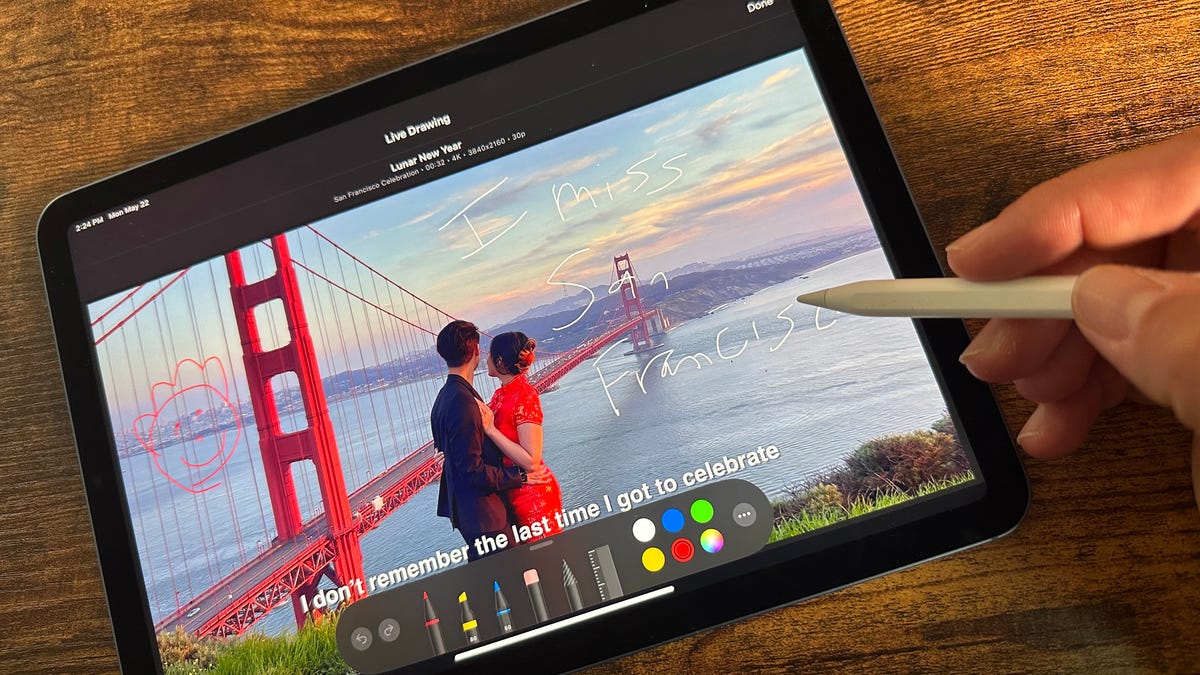I’ve had a lot of weird existential feelings trying to use Final Cut Pro for the iPad, which is available today along with Logic Pro. Existential because, well, I’m not a pro video editor. Could I be? Should I be? This is Apple’s ongoing creative invitation it extends through the possibilities of its pro hardware. I’ve been here before.
The Apple Pencil was my invitation to be an artist, and I never took it. It’s nice that it’s there, though. The same is true for Final Cut Pro, an overdue pro video editing tool made only for iPads running M1 chips or later. This is one of those pro apps I was expecting Apple to have when the M1 iPad Pro first arrived back in 2021. Now that it’s here, I’m also wondering how much I will ever personally use it.
Apple already offers free iMovie and GarageBand creative apps that are perfectly fine, although iMovie has always felt too limited in its layout and design. Final Cut Pro immediately feels a lot more flexible, with overlapping timelines for video, animation and audio, a really cool scrubbing jog wheel that feels more granular for minor edits (and brings me back to my old linear video editing days 25 years ago), and works well enough for touchscreen and keyboard/trackpad. Or, maybe, both at once.
I played around with Final Cut Pro on an iPad Air with an M1 chip, the lowest entry point in Apple’s iPad catalog that works with Final Cut Pro (the M1 and M1 iPad Pros are also supported). It worked well enough for me, although the smaller iPad display, compared to my 13-inch MacBook Air, made looking at some preview windows and track details feel a little more challenging.
I’m particularly interested in that last part because Macs still don’t have touchscreens, and some inevitable further fusion of Macs and iPads seems like it’s been in the works in slow motion for about five years now. Final Cut Pro isn’t as full-featured as the Mac version, and it’s also designed, weirdly, to funnel its output up to the Mac app but not the other way around. In that sense, it feels like an intermediary step for any pro video editor… something you’d use in the field, maybe, beginning video editing work before perhaps finishing off on a Mac.
Because the Mac app has more plug-ins (something I haven’t even begun to play with), and has the advantage of larger Mac displays and external monitors, I’d expect any video editor doing professional work to default to that, especially since Macs with M1/M2 processors are so good and small already.

Sketching or writing with the Pencil automatically can be added into video edits. This idea could be expanded even further, though.
However, I see a lot of advantages bubbling up here in Final Cut Pro on iPadOS. The scrub tool is clever (although trackpads on Macs could do something similar). Some support for instant Pencil animations opens up possibilities for ways to blend graphic art and video editing, although the doorway in Final Cut Pro feels more slightly opened than truly maximized.
It almost doesn’t matter what I think. The decision to take a dive doesn’t cost much: Apple made this and Logic Pro its first pro creative subscription apps, which cost $5 a month each and also have a one-month free trial. Turning on and off the subscription could also allow someone to work on a project only when they needed to, turn it off, and come back months later if another gig or need opened up. Projects can still be shared when the subscription is turned off, but not edited.
I’m confused by some decisions here. Final Cut Pro doesn’t support true external monitor extension, even though iPadOS and M1/M2 chips do. The app mirrors whatever’s shown on the iPad display to a connected external monitor, but it feels like this should have been a chance to stretch out the iPad Pro’s capabilities.
The subscription model also leaves me feeling very mixed: It’s a relatively affordable way to add in the pro app to your life as opposed to the $300 price on the Mac. At $50 a year, that would equal six years of use. For sure, in six years’ time, Apple will have evolved its Mac and iPad computer landscape, requiring some new software to buy anyway (not to mention whatever mixed-reality features might dovetail with the company’s rumored headsets). Maybe renting creative tools does make more sense. It’s a similar model to how Adobe works, and makes me wonder how many people will choose Apple’s new app over another like Adobe Premiere Rush, which also has multitrack timeline editing features.
But it also makes me wonder why iPad Pros just don’t come included with Final Cut Pro and Logic Pro. Or, get a year-long included subscription, much like Apple TV Plus and Apple Arcade deals get offered. Maybe that’s going to happen. Maybe Apple folds its new pro apps into yet another subscription tier in its ever-expanding subscription services catalog. It’s all a clear reminder that iPads are extremely capable of running high-end software, but I knew that already. Now I just want Mac and iPad workflows to feel even more logically interconnected, too.

